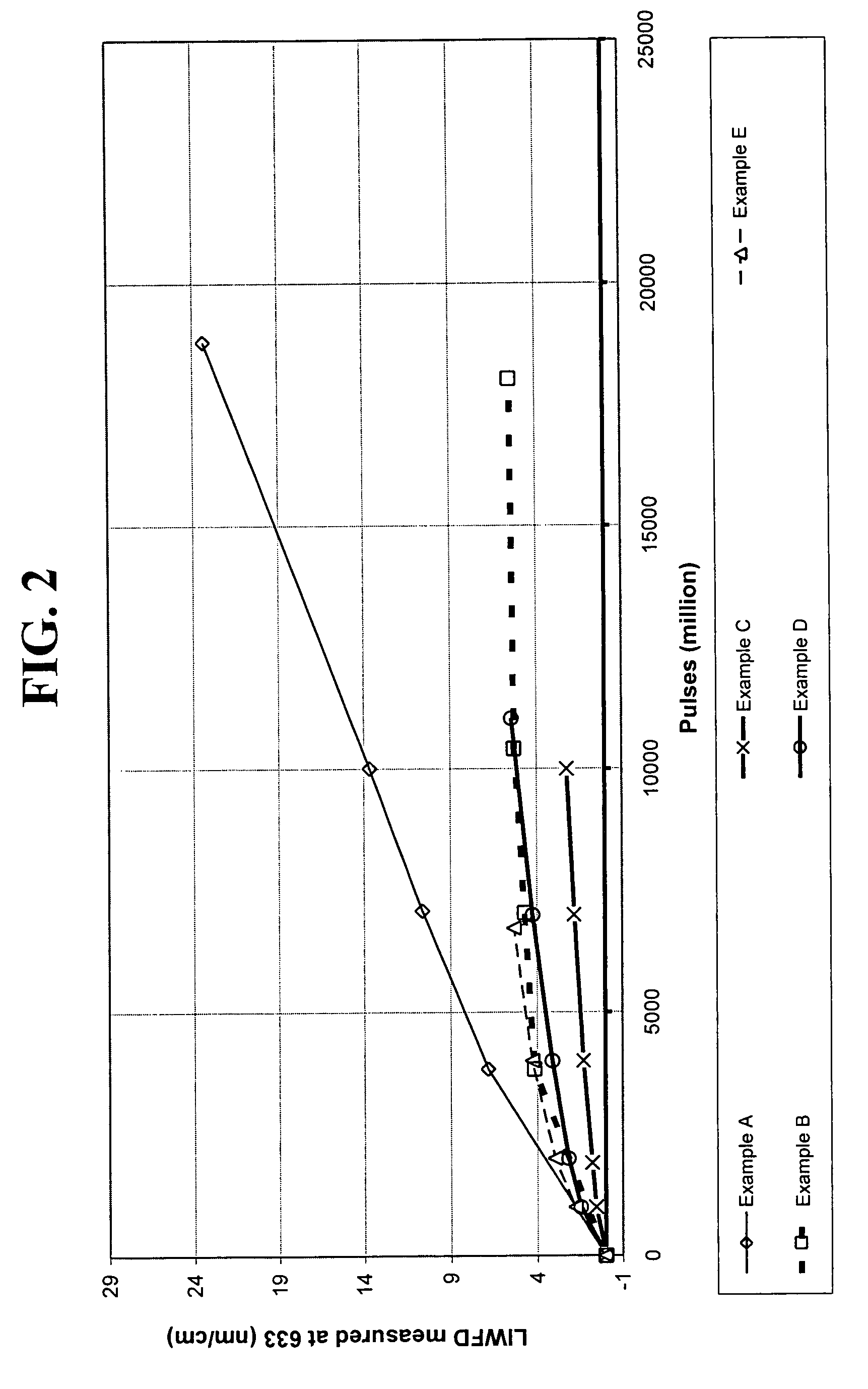Synthetic silica glass optical material having high resistance to laser induced damage
a technology of synthetic or fused silica and optical materials, which is applied in the direction of glass making apparatus, glass deposition burners, manufacturing tools, etc., can solve the problems of affecting the optical properties and performance of fused silica optics, affecting the optical properties of the optical members, and affecting the optical properties and performance of the fused silica optics. to achieve the effect of reducing the level of laser induced wavefront distortion
- Summary
- Abstract
- Description
- Claims
- Application Information
AI Technical Summary
Benefits of technology
Problems solved by technology
Method used
Image
Examples
examples
[0067]Table IV reports the H2 concentration and the OH concentration for 4 synthetic silica glass optical materials; Examples 1, 2, and 3 being inventive examples and Example 4 being a comparison example. Glass cylinders having a weight over about 5 kg were produced, as detailed below, and thereafter bars cut from the cylinders were then tested for LIWFD by exposing the bars to a pulsed laser operating at approximately 193 nm (LIWFD measured at 633 nm); note the fluence of testing for each of the samples listed in Table IV.
[0068]
TABLE IVH2 Concentration(×1017OH ConcentrationFluenceExamplemolecules / cm3)(ppm wt.)(μJ / cm2 / pulse)Example 12.01040Example 22.01070Example 31.815040Example 41.7120070
examples 1 and 2
[0069]A soot preform was made using octamethyl cyclotetrasiloxane (OMCTS) as a precursor and the OVD process as detailed above. The soot preform was then consolidated by placing it in a furnace at a temperature of 1050° C. for a period of 4 hours; a mixture of He and 2.7% Cl2 gas was flowed into the furnace atmosphere. The Cl2 functioned to strip any impurities, as well as OH, from the glass while the glass was still porous; the 4 hour period served to allow the glass body to reach its thermal equilibrium. Next the consolidation step involved holding the glass body for an additional 15 minute hold at a 1050° C. temperature while a He / 3% O2 gas mixture was flowed through the system. The so-formed glass body was then heated (in the same He / 3% O2 gas mixture) to 1235° C. at rate of 3.1° C / min, then to 1345° C. at a rate of 0.47° C. / min and then to 1490° C. at a rate of 0.42° C. / min; the gas comprising a mixture of He with 3% O2, was maintained / produced in such a manner that it was suff...
example 3
[0071]A soot preform was made using octamethyl cyclotetrasiloxane (OMCTS) as a precursor and the OVD process as detailed above. The soot preform was then consolidated by placing it in a furnace at a temperature of 1050° C. for a period of 4 hours; a gas mixture comprising He / 2.7% Cl2 was flowed into the furnace atmosphere. The Cl2 functioned to strip any impurities, as well as OH, from the glass while the glass was still porous; the 4 hour period served to allow the glass body to reach its thermal equilibrium. Next, the consolidation involved holding the glass body for an additional 15 minute hold at a 1050° C. temperature while a He / 3% O2 gas mixture was flowed through the system; the He / O2 mixture functioning as a means of combusting any residual organics present. The so-formed glass body was then heated to 1235° C. at rate of 3° C. / min, then to 1345° C. at a rate of 0.47° C. / min and then to 1430° C. at a rate of 0.25° C. / min; during the final heating steps (from 1235 to 1430° C.)...
PUM
| Property | Measurement | Unit |
|---|---|---|
| temperature | aaaaa | aaaaa |
| wavelength | aaaaa | aaaaa |
| wavelengths | aaaaa | aaaaa |
Abstract
Description
Claims
Application Information
 Login to View More
Login to View More - R&D
- Intellectual Property
- Life Sciences
- Materials
- Tech Scout
- Unparalleled Data Quality
- Higher Quality Content
- 60% Fewer Hallucinations
Browse by: Latest US Patents, China's latest patents, Technical Efficacy Thesaurus, Application Domain, Technology Topic, Popular Technical Reports.
© 2025 PatSnap. All rights reserved.Legal|Privacy policy|Modern Slavery Act Transparency Statement|Sitemap|About US| Contact US: help@patsnap.com



